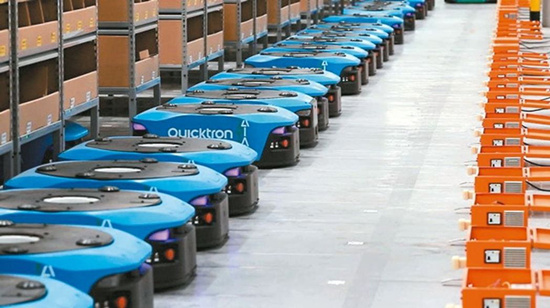By Tom McGregor, CCTV.com Panview commentator and editor
China has continued its dramatic transformation from a manufacturing-based economy and shifting towards a services-oriented one with consumption as a driving force of the domestic market.
Such changes explain the rising popularity of e-commerce for Chinese consumers, as the country's leading e-retail giants: Alibaba’s Taobao and JD.com compete for more customers and delivering goods at lower costs.
Competition breeds higher-quality products and services at reduced prices, since Alibaba and JD.com hope to grab a larger share of the e-Commerce market, both companies have utilized hi-tech upgrades and devices, such as drones to quicken the pace of package deliveries.
Meanwhile, Alibaba has constructed a massive 3,000-sq/m warehouse in Huiyang, Guangdong Province that is fully-operated by IoT (Internet of Things) and large fleet of robot workers.

(Robot workers in the warehouse in Huiyang Photo from Internet)
Caioniao - logistics arm
In July 2017, Cainiao, logistics subsidiary of Alibaba Group, opened it's smartest warehouse with China's largest population of robots. Mobile robot, known as AGVs (automated guided vehicles), come equipped with WiFi and self-charging batteries.
Cainiao offers either same-day or next-day deliveries to over 1,000 regions of China. When somebody logs on to Taobao and they click on shipping request for an item that starts IoT and robot workers into action.
An AGV receives transmission of order and locates item in warehouse and delivers it to clerk. Robots can conduct 3,000 orders in an 8-hour shift, while routinely human workers could do 1,500 orders in the same time-frame.
Robots can travel at 1.5-m/sec or 5-ft/sec and carry up to 600-kilograms per load. A fleet of 100 AGVs have sensors to avoid collisions and are controlled by human managers using IoT.
Huawei joins in
When it comes to artificial intelligence (AI) and IoT development, China's leading players are called, BAT (Baidu Inc., Alibaba Group and Tencent Holdings), and telecommunications equipment and devices manufacturer, Shenzhen-based Huawei Technologies, has jumped into the fray.
In early September 2017, Huawei and DHL Supply Chain announced a joint project to develop an IoT system to upgrade logistics for an automobile factory in a test-pilot run.
The two companies would launch narrowband IoT, NB-IoT application at an automotive manufacturing site in Liuzhou, Guangxi Zhuang Autonomous Region.
"Waiting time for drivers will be halved from an average of 40 minutes to 20 minutes and the risks of manufacturing delays are significantly reduced as materials arrive in time and resources are optimized by the IoT solution," China.org quotes Markus Voss, chief operating officer (COO) of DHL Supply Chain, as saying.
Search for better solutions
"The cross-industry effort made by Huawei and DHL has enlightened industrial players to find a way out amid the fragmented logistics battling all these years with high costs due to the uneven resources, supply and demand of products," said Lin Guolong, director of Shanghai Maritime University Logistics Research Center.
Experts have taken note that by leveraging existing infrastructure with limited investments then IoT solutions can be designed to streamline overall factory management for inbound-to-manufacturing logistics that can enhance processing time at the site, said Voss.
Zou Yin, CEO DHL Supply Chain Greater China, disclosed NB-IoT was co-developed by Huawei and China Mobile. "Exploring new technologies, like NB-IoT is one of many ways we are forging forward with our digitalization journey in China," said Zou.
By optimizing IoT applications in logistics, we can see improved performance at lower costs.
Overcoming logistics logjams
China's Ministry of Commerce issued the 2016 Commerce Logistics Operations Report disclosing that in China alone RMB11.1 trillion (US$1.7 trillion) was spent on logistics in 2015, witnessing 2.9 percent year-on-year growth and accounting for 14.9 percent of the country’s GDP (gross domestic product).
Nevertheless in the United States, logistics costs account for 6.5 percent GDP, while in Japan and Germany it stands at 3.5 percent. Apparently, China is struggling with rising land prices for building warehouses and management and labor costs.
Here's where IoT can provide added-value to the logistics industry.
"By 2025, the Internet of Things will have the potential to generate up to 1.77 trillion euros (US$2.12 trillion) in additional value for the international logistics industry," China.org quotes Voss as saying. "Our (DHL) goal is to enable a more integrated logistics value chain through greater connectivity enhancing the customer experience."
Hyperconnectivity Era
Hi-tech experts are forecasting that by 2020, there will be over 50 billion networked devices, leading to a Hyperconnectivity era. Manufacturing and logistics will be set up with IoT systems, such as Warehouse Management System (WSM) and Transportation Management System (TMS).
In regards to delivery shipments, companies can tap into cloud, GPS and Beidou Navigation System, RFID (radio frequency identification), while chips can transmit data, including: identification (tracking and tracing), location, temperature, weather conditions, traffic reports and much more.
IoT can play crucial roles in transportation with control over vehicles used for making deliveries. We can anticipate a future of more cameras and sensors installed on roads, which can transmit data to cloud, while IoT can manage the entire system.
Chinese scientists and inventors are working overtime to develop groundbreaking technologies in IoT, which can usher in a revolution in the manufacturing and logistics industries.
(The opinions expressed here do not necessarily reflect the opinions of Panview or CCTV.com. )

Panview offers a new window of understanding the world as well as China through the views, opinions, and analysis of experts. We also welcome outside submissions, so feel free to send in your own editorials to "globalopinion@vip.cntv.cn" for consideration.
















